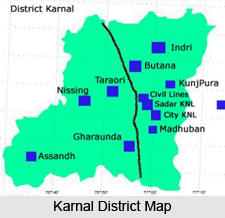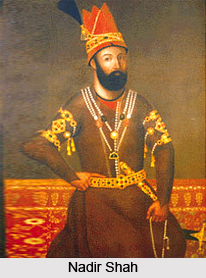 Karnal District is one of historical districts of Haryana. It is also known as `Daanveer Karn`. Karnal city is the district headquarters. Karnal District is known all over the world for production of rice, wheat and milk. It is also known for agriculture research Institutions like NDRI, CSSRI, Wheat Research Directorate, National Bureau of Animal Genetics Resources, Sugarcane Breeding Institute etc. Karnal District was also a district in erstwhile Punjab.
Karnal District is one of historical districts of Haryana. It is also known as `Daanveer Karn`. Karnal city is the district headquarters. Karnal District is known all over the world for production of rice, wheat and milk. It is also known for agriculture research Institutions like NDRI, CSSRI, Wheat Research Directorate, National Bureau of Animal Genetics Resources, Sugarcane Breeding Institute etc. Karnal District was also a district in erstwhile Punjab.
Location of Karnal District
Karnal District lies on the western Bank of Yamuna River which traverses about 11 kms to the east, forming the eastern boundary of the district. River Yamuna separates Haryana from Uttar Pradesh. Karnal District including Panipat lies between 29 degree 9 minutes 50 seconds and 29 degree 50 minutes north latitude and 76 degree 31 minutes 15 seconds and 77 degree 12 minutes 45 seconds east longitude. Average altitude of Karnal District from sea level is between 235 and 252 meters. Karnal District is surrounded by Kurukshetra District on its north-west, by Jind District and Kaithal District on its west, by Panipat District on its south and by Uttar Pradesh on its east.
History of Karnal District
Karnal is said to have been founded by Karna. Karnal District came into prominence in the year 1739 when Nadir Shah defeated Muhammad Shah at Karnal. Raja Gopal Singh of Jind seized Karnal in 1863, and the Mahrattas established themselves at Karnal in 1785.
 Skirmishes however, followed between the Mahrattas and the Sikhs. In 1795 the Mahrattas finally wrested it from Raja Bhag Singh of Jind and made it over to George Thomas, who took part in the fight. Meanwhile Raja Gurdit Singh of Ladwa obtained possession of Karnal. It was captured by the British rulers in 1805 and made over to Muhamdi Khan (Mandal). Karnal, on being formed into a British cantonment, the fort which had been built by Raja Gajpat Singh of Jind, was taken over by the British. In the year 1862, it was given to the Education Department.
Skirmishes however, followed between the Mahrattas and the Sikhs. In 1795 the Mahrattas finally wrested it from Raja Bhag Singh of Jind and made it over to George Thomas, who took part in the fight. Meanwhile Raja Gurdit Singh of Ladwa obtained possession of Karnal. It was captured by the British rulers in 1805 and made over to Muhamdi Khan (Mandal). Karnal, on being formed into a British cantonment, the fort which had been built by Raja Gajpat Singh of Jind, was taken over by the British. In the year 1862, it was given to the Education Department.
Geography of Karnal District
Yamuna River forms the eastern boundary of Karnal District and flows from north to south. The district is a part of Indo Gangetic plain and has a well spread net work of western Yamuna canal. Its geographical area has been divided into three agro climatic regions, Khadar, Bhangar and Nardak belt. Khadar starts from Indri-Karnal road one mile away from Karnal covering the area in between Yamuna River and National Highway number 1 up to Patti-Kalyana village. Bhangar area starts from west of Khadar area covering Gharaunda development block. The nardak area lies in Nissing, Nilokheri and Assandh development block. However, its water is saline and not fit for irrigation.
Administration of Karnal District
Deputy Commissioner runs the district administration, and is responsible for maintenance of law and order and redresses the grievances of the public and implements all the policy decisions of the government. Karnal District is divided into two Sub Divisions, five tehsils and three sub tehsils. It has 435 villages. The total population of Karnal District as per 2001 Census is 12,74,843.
Tourism in Karnal District
There are various popular places of interest in Karnal District. The historic sites of this district offer a glimpse of the rich history associated with the district. Cantonment Church Tower, Dargah Nuri, Miran Sahib`s Tomb, Kalander Shah`s Tomb, Gurudwara Manji Sahib, Devi Temple, Kunjpura, Basthali, Gondar, Shamgarh and Sita Mai Temple are some of the prominent tourist sites of Karnal District.
Karnal is an important city on Delhi Ambala Rail Line and Grand Trunk Road, connected with all important places in the country. It is 123 kms from Delhi and 130 kms from Chandigarh.






